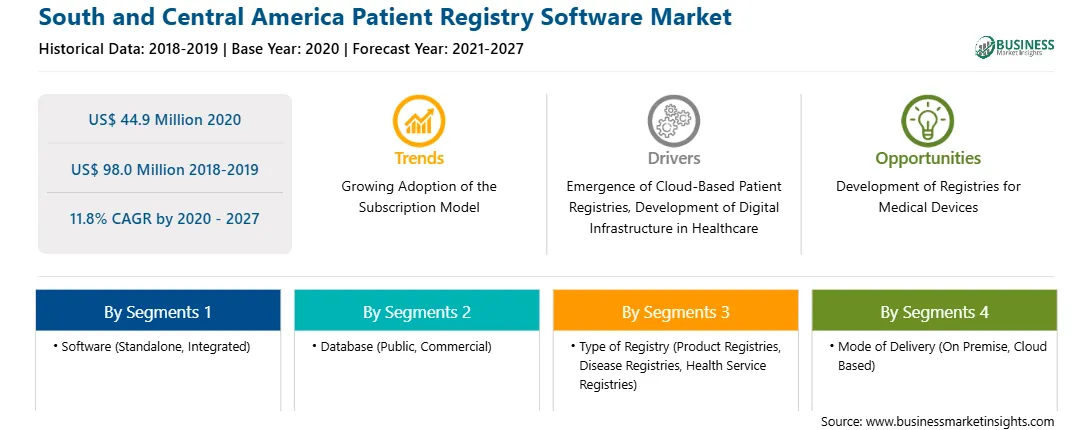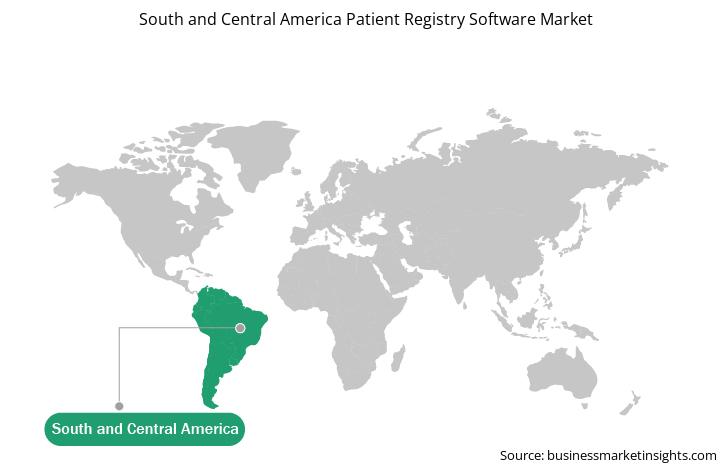South and Central America Patient Registry Software Market
No. of Pages: 119 | Report Code: TIPRE00022949 | Category: Technology, Media and Telecommunications
No. of Pages: 119 | Report Code: TIPRE00022949 | Category: Technology, Media and Telecommunications
A patient registry is the database that collects uniform data about a population of disease or condition, and that aids a predefined clinical or scientific. Patient registry software contains databases that are maintained through collection of secondary data related to diagnosis, procedure, or condition of patient, for noting the number of new medical devices being used or going through a new procedure. The patient registry software plays a crucial role in post-marketing surveillance of pharmaceuticals.
Thus, a development of digital infrastructure in healthcare is expected to create a significant demand for patient registry software in the coming years, which is further anticipated to drive the patient registry software market.
The COVID-19 is expected to result in the region's worst recession, causing a 9.1% contraction in regional GDP in 2020. This is expected to increase the number of poor up by 45 million and the extremely poor number by 28 million. The COVID‐ 19 pandemic is a critical test for the already overburdened and underfunded public healthcare systems of South and Central America. It suffers from severe inequalities. State-run hospitals and clinics are already overstressed by the treatment of vector‐borne diseases and community‐acquired infections and high rates of non‐communicable diseases (NCDs). Also, the prevention and treatment of NCDs have been critically affected since the onset of the COVID-19 in the region, as per the Pan American Health Organization (PAHO). Before COVID-19, approximately 81% of all deaths in the region were due to NCDs. An estimated 62 million people live with diabetes, and 1.2 million live with cancer in South and Central America. Moreover, in South and Central America, the Gross Domestic Product (GDP) and central government healthcare expenditure are significantly lower than in developed countries. In 2018, as per the United Nations, Economic Commission for Latin America (CEPAL), 16 South American countries invested less than 4% of their GDP to healthcare. The consequences of a lack of investment in public healthcare systems are reflecting during the pandemic. The COVID‐19 pandemic is exacerbating these inequalities by threatening the infrastructure and capacity of state‐owned healthcare systems. Thus, the factors mentioned above are negatively impacting the growth of the market in the region.

Strategic insights for the South and Central America Patient Registry Software provides data-driven analysis of the industry landscape, including current trends, key players, and regional nuances. These insights offer actionable recommendations, enabling readers to differentiate themselves from competitors by identifying untapped segments or developing unique value propositions. Leveraging data analytics, these insights help industry players anticipate the market shifts, whether investors, manufacturers, or other stakeholders. A future-oriented perspective is essential, helping stakeholders anticipate market shifts and position themselves for long-term success in this dynamic region. Ultimately, effective strategic insights empower readers to make informed decisions that drive profitability and achieve their business objectives within the market.

| Report Attribute | Details |
|---|---|
| Market size in 2020 | US$ 44.9 Million |
| Market Size by 2027 | US$ 98.0 Million |
| Global CAGR (2020 - 2027) | 11.8% |
| Historical Data | 2018-2019 |
| Forecast period | 2021-2027 |
| Segments Covered |
By Software
|
| Regions and Countries Covered | South and Central America
|
| Market leaders and key company profiles |
The geographic scope of the South and Central America Patient Registry Software refers to the specific areas in which a business operates and competes. Understanding local distinctions, such as diverse consumer preferences (e.g., demand for specific plug types or battery backup durations), varying economic conditions, and regulatory environments, is crucial for tailoring strategies to specific markets. Businesses can expand their reach by identifying underserved areas or adapting their offerings to meet local demands. A clear market focus allows for more effective resource allocation, targeted marketing campaigns, and better positioning against local competitors, ultimately driving growth in those targeted areas.

The South and Central America patient registry software market is expected to grow from US$ 44.9 million in 2020 to US$ 98.0 million by 2027; it is estimated to grow at a CAGR of 11.8% from 2020 to 2027. The use of medical information from clinical registries is gradually increasing worldwide. Clinical registries capture broad-scope data by using a mixture of manual and automated methods. Further, in 2016, the National Quality Registry Network (NQRN) ruled out a list of registries based on publicly available sources. These registries focus on aspects such as quality improvement, population management benchmarking, comparative effective research (CER), family medicine, lung cancer screening, interventional radiology, and metabolic and bariatric surgery. The availability of free license for patient registries increases their adoption in healthcare centers. The availability of many disease registries helps doctors and other clinical professionals identify and compare all available practices, followed by adopting the best one; this process uplifts the performance of this healthcare sector, thereby bolstering the adoption of patient registry software.
In terms of software, the integrated segment accounted for the largest share of the South and Central America patient registry software market in 2019. In terms of database, the commercial segment held a larger market share of the patient registry software market in 2019. In terms of type of registry, the disease registry segment held a larger market share of the patient registry software market in 2019. In terms of mode of delivery, the cloud-based segment held a larger market share of the patient registry software market in 2019. In terms of pricing model, the subscription segment held a larger market share of the patient registry software market in 2019.
A few major primary and secondary sources referred to for preparing this report on the patient registry software market in South and Central America are company websites, annual reports, financial reports, national government documents, and statistical database, among others. Major companies listed in the report are IQVIA Inc.
By Software
By Database
By Type of Registry
By Mode of Delivery
By Pricing Model
By Country
The South and Central America Patient Registry Software Market is valued at US$ 44.9 Million in 2020, it is projected to reach US$ 98.0 Million by 2027.
As per our report South and Central America Patient Registry Software Market, the market size is valued at US$ 44.9 Million in 2020, projecting it to reach US$ 98.0 Million by 2027. This translates to a CAGR of approximately 11.8% during the forecast period.
The South and Central America Patient Registry Software Market report typically cover these key segments-
The historic period, base year, and forecast period can vary slightly depending on the specific market research report. However, for the South and Central America Patient Registry Software Market report:
The South and Central America Patient Registry Software Market is populated by several key players, each contributing to its growth and innovation. Some of the major players include:
The South and Central America Patient Registry Software Market report is valuable for diverse stakeholders, including:
Essentially, anyone involved in or considering involvement in the South and Central America Patient Registry Software Market value chain can benefit from the information contained in a comprehensive market report.